my main account with a bunch of random stuff ¦ go to @anotherlnlylife for ocs and more
Don't wanna be here? Send us removal request.
Text

IT'S HERE
Case Three: Chapter Two of Citadel is now widely available! Enjoy the longest chapter of Citadel so far - can your intern survive night shift in the surgical ICU?
In celebration of the new chapter release and for hitting 3500+ followers, 3 lucky winners will receive the choice of either a short snippet or the ability to name a side character in Citadel.
If you like this post, you’ll be entered into the raffle once.
If you reblog this post, you’ll be entered into the raffle twice.
If you like and reblog, that's a total of 3 raffle entries!
Raffle will close Saturday, July 6th at 9:00 pm EST.
Psst...don't want to replay the game from the beginning to explore different character builds and different romance options? Members of Patreon resident tier and up (starting at $5/month) will have access to a Patreon-exclusive demo that will allow you to change your character and romance stats before beginning Case Three: Chapter Two.
If you run into any coding errors during your playthrough, please send me an ask with the line number of the code.
Cheers!
-Bouncy
Links:
TUMBLR INTRO POST
DEMO || DISCORD || PATREON || KO-FI || AO3 ||FORUM||
586 notes
·
View notes
Text
A Comprehensive Guide for Writing Advice
Sometimes, despite enjoying writing so much, something is not working for you. Maybe your well of ideas has run dry. Or your WIP has hit a corner and you can't find your way out to the end of the story. Or you need to go back to your finished draft and see if there are any kinks to clear up.
Fortunately, everyone at Writeblrcafé has experienced such, and to help you out, we have a bunch of links to helpful posts by fellow writers to help you along on your writing journey as well as some helpful links to other websites, resources and software.
General:
WHY IS WRITING IS SO FUCKING HARD? (@writers-hq)
Writer Block First Aid Kit (@isabellestone)
Websites for writers (masterpost @2soulscollide)
Writing advice (masterpost @theliteraryarchitect)
Writing resources (masterpost @stinastar)
One look thesaurus (a reverse dictionary where you can enter words or concepts)
Coming Up with Ideas:
97 Character Motivations (@theplottery)
Character Flaws (@fantasyfillsmysoul)
Character Profile (@mistblossomdesigns)
Characters Unflawed (@emptymanuscript)
Why Theme is More Important than Plot (@theplottery)
Weekly writing prompts on Reedsy
Drafting:
3 of the worst story beginnings (and how to fix them) (@theplottery)
Cheat Sheet for Writing Emotion (@myhoniahaka)
Creative Writing for Writers (@writerscreed)
Describing Physical Things (@wordsnstuff)
How to Craft a Natural Plot (@theplottery)
How to Write a Story? (masterpost @creativepromptsforwriting)
How to write: ethnicity & skin colour (@youneedsomeprompts)
What the F is Show Not Tell (@theplottery)
Writing advice from my uni teachers (@thewritingumbrellas)
First Draft: story outlining template meant to help with planning your next big writing project (@fauxriot)
The wonder/ discovery arc (@evelynmlewis)
How to structure a chapter (@theplottery)
How to pace your storytelling (@charlesoberonn)
How to write and research mental illness (@hayatheauthor)
Seven Blogs You Need To Read As An Author (@hayatheauthor)
Editing/Revising:
Eight steps in making the editing process of your book easier (@joaneunknown)
Kill Your Darlings (@tibodine)
Self editing tips (first pass) (@projecttreehouse)
Publishing:
Chill Subs: biggest database for literary magazines and small presses; track your submissions and get your writing published!
5 steps to get your novel ready to self-publish (by @nanowrimo)
Resources for finishing and publishing your novel (masterpost by @nanowrimo)
For self-publishing: this page gives you the exact pixel count of a book spine based on its page count, and/or a template you can use for the correct width/height ratio.
Software:
Scrivener: one time payment of $60 or 70€ (macOS/windows), $24 (iOS; no Euro listed for iOS); used by professionals, many tools to write and organize your novel
Bibisco: free and "pay what you want" version; multilingual, world building, character profiles, writing goals, story timeline, mind maps, notes and more templates to write a novel.
Manuskript: free open source-tool; outliner, novel assistant, distraction-free mode
Ghostwriter: a free and open alternative which has a decent interface with some interesting features, like Hemingway Mode, which disables one's backspace and delete keys, emulating a typewriter.
NaNoWriMo: an international contest to encourage writers to finish writing their novel with many events, groups for exchange with fellow writers, helpful writing advice and help for self-publishing and publishing traditionally.
Campfire Writing: website, desktop app, and mobile app, with tools built in to help manage characters, magic systems, research, etc. It has a great free option, plus monthly, annual, and lifetime purchase options. It also has built-in NaNoWriMo compatibility and a catalogue of tutorials and writing advice videos (suggestion by @harfblarf)
Websites And Writing Apps Every Author Needs In 2023 (@hayatheauthor)
Let us know in the comments if there are any links we could add to it! Reblog this post to help a fellow writer.
Support our work by buying a cup of coffee on KoFi.
3K notes
·
View notes
Text

[ DEMO (TBA) ] - [ PINTEREST (TBA) ] - [PLAYLIST (TBA) ]
🍃 This is the dev blog for my interactive fiction if set in the Naruto universe titled Mata Aetara ~!
🍃 Sorry there’s not much here at the moment as the story being written is still SUPER early in development ~! Please keep in mind I’m new to writing and creating an if so it will take a while for things to come out, and I’m doing this for fun so I don’t want to rush or put any pressure on myself. If you’re still interested in following my progress thank u so much I appreciate it 🥰
Summary & Features:
Slice of life, but make it Naruto. It's been 4 years since The Nine Tailed Fox wreaked havoc on your village, and things have, for the most part returned to normal. You start off at playing as a genin who graduated from the academy about a year ago. Your team, and your friends teams have only been taking on the lowest level missions, but it's about time to start taking higher ranking ones! How will you maneuver life in The Hidden Leaf Village?
Choices you can make:
name
gender, pronouns, & sexuality
hair style, texture, & color
eye color
skin color & details
height
you are the medical-ninja of your team, choose to master it or learn various jutsus
chakra nature
summoning animal
small weapon
RO info & tags below ⬇️

Asahi Uchiha
he/him
One of your teammates, a member of team 3
From the Hidden Leaf Village
One of your childhood best friends, and the most talented shinobi in your class. With how humble he is you could almost say it happened accidentally though. Prefers only having a few close friends and would go to the end of the Earth for them
Niko Sarutobi
they/them
One of your teammates, a member of team 3
From the Hidden Leaf Village
Your other childhood best friend! The opposite of Asahi and will make friends wherever they go! Will always put you and Asahi first though! Is also very flexible
Shikako Nara
she/her
A member of team 5
From the Hidden Leaf Village
A shy girl from the Nara clan. Tends to think her jutsu is never good enough, but her teammates are always there to reassure her!
Inoru Yamanaka
he/him
A member of team 5
From the Hidden Leaf Village
Not a fan of Asahi, as he thinks he was the best shinobi in your class (he wasn't). Despite that, he is very talented so he has a right to be confident. As he gets older, his confidence and charisma continue to grow
Rona Inuzuka
she/her
A member of team 13
From the Hidden Leaf Village
Her clan members can be a little chaotic, so she likes to be the responsible one wherever she goes. Safe to say she's the mom friend of your group
Jun Hyuga
he/him
A member of team 13
From the Hidden Leaf Village
Jun is from the side branch of the Hyuga clan and tends to be quiet and reserved. He is usually uninterested in the antics you and your friends get into
Might Chai
she/her
A member of team 13
From the Hidden Leaf Village
Chai has no talent for any jutsu other than taijutsu, just like her father and older brother. She doesn't let that get her down though! She'll do everything possible to show she's a capable kunoichi just like everyone else!
Mokoto Aburame
they/them
A member of team 9
From the Hidden Leaf Village
As long as you don't squish any bugs around them, you'll get along great. Most people call Mokoto creepy, but it's just because they dress in dark colors, don't talk much, and of course, the bugs.
Ryoku
he/him
A member of the sand team
From the Hidden Sand Village
A member of the Kazekages clan, Ryoku was born with their ability to control sand with their chakra. He has a serious personality and will protect his village with his life.
Kougetsu Hozuki
they/them
A member of the mist team
From the Hidden Mist Village
Kougetsu is an adventurous and unpredictable ninja from the very dangerous Hidden Mist Village. You never know what their next move will be. They like to keep you on your toes.

Important tags to know:
🍃 "ch: [name]" : any info, answered asks, or aesthetics related to the charater
🍃 "ch: [team name/number]" : any info, answered asks, or aesthetics related to the team of characters
🍃 "ro asks" : any reaction / scenario asks answered about the ros
🍃 ".txt" : general text posts about Mata Aetara
🍃 "info" : information regarding Mata Aetara
🍃 "aesthetic" : and posts that give me inspiration about Mata Aetara
🍃 "q" : queued posts
🍃 "my art" : art / edits I've made for Mata Aetara
🍃 "your art" : any fanart / fan edits made related to Mata Aetara
🍃 "picrew" : any picrews I do of the characters
410 notes
·
View notes
Text
Words to use instead of ‘said’
**Using the word ‘said’ is absolutely not a bad choice, and in fact, you will want to use it for at least 40% of all your dialogue tags. Using other words can be great, especially for description and showing emotion, but used in excess can take away or distract from the story.
Neutral: acknowledged, added, affirmed, agreed, announced, answered, appealed, articulated, attested, began, bemused, boasted, called, chimed in, claimed, clarified, commented, conceded, confided, confirmed, contended, continued, corrected, decided, declared, deflected, demurred, disclosed, disputed, emphasized, explained, expressed, finished, gloated, greeted, hinted, imitated, imparted, implied, informed, interjected, insinuated, insisted, instructed, lectured, maintained, mouthed, mused, noted, observed, offered, put forth, reassured, recited, remarked, repeated, requested, replied, revealed, shared, spoke up, stated, suggested, uttered, voiced, volunteered, vowed, went on
Persuasive: advised, appealed, asserted, assured, begged, cajoled, claimed, convinced, directed, encouraged, implored, insisted, pleaded, pressed, probed, prodded, prompted, stressed, suggested, urged
Continuously: babbled, chattered, jabbered, rambled, rattled on
Quietly: admitted, breathed, confessed, croaked, crooned, grumbled, hissed, mumbled, murmured, muttered, purred, sighed, whispered
Loudly: bellowed, blurted, boomed, cried, hollered, howled, piped, roared, screamed, screeched, shouted, shrieked, squawked, thundered, wailed, yelled, yelped
Happily/Lovingly: admired, beamed, cackled, cheered, chirped, comforted, consoled, cooed, empathized, flirted, gushed, hummed, invited, praised, proclaimed, professed, reassured, soothed, squealed, whooped
Humour: bantered, chuckled, giggled, guffawed, jested, joked, joshed
Sad: bawled, begged, bemoaned, blubbered, grieved, lamented, mewled, mourned, pleaded, sniffled, sniveled, sobbed, wailed, wept, whimpered
Frustrated: argued, bickered, chastised, complained, exasperated, groaned, huffed, protested, whinged
Anger: accused, bristled, criticized, condemned, cursed, demanded, denounced, erupted, fumed, growled, lied, nagged, ordered, provoked, raged, ranted remonstrated, retorted, scoffed, scolded, scowled, seethed, shot, snapped, snarled, sneered, spat, stormed, swore, taunted, threatened, warned
Disgust: cringed, gagged, groused, griped, grunted, mocked, rasped, sniffed, snorted
Fear: cautioned, faltered, fretted, gasped, quaked, quavered, shuddered, stammered, stuttered, trembled, warned, whimpered, whined
Excited: beamed, cheered, cried out, crowed, exclaimed, gushed, rejoiced, sang, trumpeted
Surprised: blurted, exclaimed, gasped, marveled, sputtered, yelped
Provoked: bragged, dared, gibed, goaded, insulted, jeered, lied, mimicked, nagged, pestered, provoked, quipped, ribbed, ridiculed, sassed, teased
Uncertainty/Questionned: asked, challenged, coaxed, concluded, countered, debated, doubted, entreated, guessed, hesitated, hinted, implored, inquired, objected, persuaded, petitioned, pleaded, pondered, pressed, probed, proposed, queried, questioned, quizzed, reasoned, reiterated, reported, requested, speculated, supposed, surmised, testified, theorized, verified, wondered
This is by no means a full list, but should be more than enough to get you started!
Any more words you favor? Add them in the comments!
Happy Writing :)
15K notes
·
View notes
Text
oc asks: character design edition
FACE & FEATURES
glance: At first glance, what stands out most about your OC's appearance? What's their distinguishing feature?
face: Describe your OC's face. What's their smile like? Are their orbs cerulean? What would someone notice first when looking at them?
stature: What's your OC's body type? How tall are they? Do they wear clothing to accentuate their look or do they try to mask it?
motion: How does your OC move? How does their clothing help or hinder their range of motion? Are they flexible, coordinated, clumsy?
stillness: How does your OC act while still? Are they fidgety? Do they have any common gestures or tics? Does their clothing affect how they hold themselves while at rest?
canvas: Does your OC have any scars, piercings, tattoos, or other markings? Do they display or cover them up at all?
CUT & CLOTHES
night: What does your OC wear to sleep? Do they have a favorite pair of PJs, or are they more the birthday suit type?
day: What does your OC wear on a normal day? Why do they default to those clothes? Do they wear similar things, or do they change it up?
formal: What's your OC's formal look? Do they like dressing up? Do they have different looks for different occasions?
informal: What's your OC's lazy-day look? How do they like to dress when they're winding down?
outerwear: What's your OC's outerwear situation? Jacket, sweater, cloak? What sort of weather do they deal with most and how do they protect themselves?
footwear: What does your OC wear on their feet?
road: What does your OC wear while traveling? Do they have high-quality equipment, or are they making do? What does their gear look like?
armor: What kind of armor does your OC wear? Is it well kept? Bonus: where does it come from? Is there a story behind it?
arms: Does your OC have any weapons? What weapons do they carry, and how do they wear them when they're not fighting?
roots: Is your OC's look inspired by any specific style of clothing or fashion trend? What are the roots and/or inspiration for their look?
texture: Does your OC favor any specific kinds of cloth or textures? Is there anything they can't wear or don't like? What sort of fabrics do they prefer?
wardrobe: How big is your character's wardrobe? Do they wear things threadbare, or can they afford new clothes often? Are they any good at mending and repairing their own clothing?
ACCESSORIES & ACCENTS
bling: What jewelry does your OC wear? Does it have any meaning?
hair: How does your OC wear their hair? Does it have some kind of meaning?
makeup: Does your OC wear makeup? How often? What kind? Why do they wear makeup, and do they like it?
favorite: Does your OC have a favorite article of clothing or accessory? What is it? What's the meaning behind it? Do they wear it all the time or do they wear it sparingly to keep it safe?
change: Has your OC ever drastically changed their appearance? Significant haircuts, big tattoos, complete wardrobe swap, etc? Why? How do they feel about the change?
alternate: What would your OC's alternate universe look be? If they're a fantasy character, what's their modern look? If they're sci-fi, what's their fantasy look? What AU would you want to see your OC in, and how would they dress themself? Bonus: Prompt an AU!
8K notes
·
View notes
Text
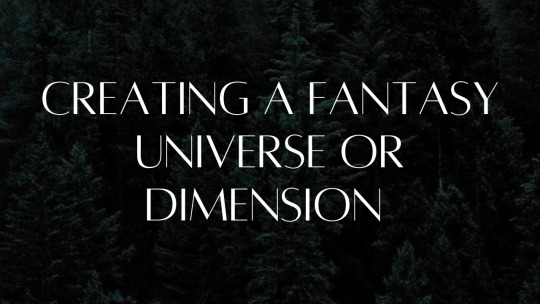

Creating a universe for a book can be a complex and creative process that involves a lot of world-building. To create a universe for a book, you must first establish the basic elements of the world, such as its geography, history, culture, and politics.
You will then need to create characters, plot, and a story that fits within the universe they have created. You may choose to create detailed maps, history, and culture. You may also want to create a set of rules and physics that govern how the world operates.
The process of creating a universe can be both exciting and challenging, as it requires you to think deeply about the world they are creating and to make decisions about how it functions. But ultimately it will add depth and richness to the story and make the reading more enjoyable for the audience.
I have created a universe, but turned it into a dimension after a long and hard year of thinking of what I wanted to do with it. I hope that this post helps you guys start on creating your worlds as well. Keep in mind that this is not all that you need to know and some of this you may already know!
Coming up with a name for your universe:
Consider the theme or tone of your universe. If it is a fantasy world, you may want to choose a name that evokes a sense of magic or wonder. If it is a science-fiction universe, you may want to choose a name that sounds futuristic or technological.
Think about the culture or history of your universe. If your universe has a specific culture or history, you may want to choose a name that reflects that.
Use a thesaurus or other word reference to find synonyms or related words. This can help you come up with new and unique ideas for your universe's name.
Play with different languages, combining words or using words from different languages to create a unique name.
Consider using a name that is symbolic or metaphorical. This can help you convey the theme or tone of your universe in a subtle and powerful way.
Creating a fictional race:
Consider the physical characteristics of your race. What do they look like? Do they have any unique features or abilities? How do these characteristics affect their way of life and culture?
Think about the society and culture of your race. What are their beliefs, values, and customs? How do they govern themselves? What is their technology level?
Consider the role of your race in your universe. Are they the main characters or just a secondary race? How do they interact with other races in your universe?
Take inspiration from real-world cultures and myths. You can borrow elements from different cultures and myths to create a unique and believable race.
Please please PLEASE avoid stereotypes and cliches. Fictional races should be original and not based on existing stereotypes or cliches. You do not want to be insensitive towards a group of people by feeding into the negative stereotypes.
Give your race a unique language, naming convention, and history. This will give them a sense of realism and depth. This can be hard, so I know a few people that have hired linguists for this (however this is pricy and I know not many people can do this)
Creating a fantasy language:
Start with the basics of language structure. Decide on the phonemes (basic sounds) and grammatical rules for your language.
Use inspiration from existing languages. You can borrow elements from different languages to create a unique and believable fantasy language.
Create a vocabulary. Come up with words for common objects, actions, and ideas.
Consider the culture and history of the race that speaks the language. Does it have any influences on the language? How does it reflect the beliefs and values of the race?
Keep it consistent. Once you have established the basic structure and vocabulary of your language, make sure to stick to it throughout your story.
Give your language a writing system. Create an alphabet, symbols or characters that can be used to write the language.
As said before, don't hesitate to use a linguist or a language creator tool to help you create the language in a more accurate and professional way.
Again, this is not all that goes into created a universe or dimension of your own, but it's a step towards having a fleshed out world that your readers will love.
One thing I did not see, however, was that you will want to make sure that you keep your word in a document! Keep it written down if you prefer, but put it down somewhere. I created a template for myself when I was world building and it helps a lot. There's also a book that has helped me with thinking kore in depth and I will be sharing that soon!

1K notes
·
View notes
Note
Hello! Do you have some advice on how to create and write a cult?
Hi!
I’m really interested in cults and their behaviour and structure, so I actually had a problem to not go overboard here. I will start with a short overview of the basics and then go into more detail. I hope you like it!
How to create and write a cult
The Leader
common characteristics: charismatic, manipulative, controlling
followers follow them without questioning them
they are often seen as a prophet or human idol or image of the diety the cult believe in
they speak with the authority of a god
make sure to give them some uniqueness, maybe an air of otherworldliness to make them more godlike so they stand out
give reasons for why they want a following, what do they get out of it?
give reasons for why people would follow and be loyal to them
The Followers
often disenchanted from society and their own beliefs
wanting something new, a new start
single people, living on their own
often without close ties to family or friends
remember that everyone, no matter their intelligence and their confidence can become entangled in a cult
some are just a little bit easier to prey on
The Cult
often strict hierarchy
rules, routines and practiced behaviours
love bombing and brainwashing
feeling of superiority
being the good guys in an “us against the world”-scenario
taking everything from the outside away that a new member could rely on
making them solely rely on the cult
if someone does escape they are either pursued, stalked and harrassed or they are being shunned by everyone in the cult
Structure
cults typically have one godlike leader
they do not get questioned, they get imitated and followed
they have a small, but extremely loyal group of followers around them
this core group implements the leader’s rules and controls the rest of the followers
they often have more benefits and liberties than the rest
a normal follower would probably mostly interact with someone from the core group as the person in charge and not the leader themself
depending on the cult, the other followers can be separated and put into smaller households
this can break up pre-existing units and helps controlling the members
Examples:
nuclear family
one man and a harem of women and younger children
separated by gender (younger boys with women)
separated by skill
separated by age
separated into “classes”
Beliefs
a religious cult can be independent or a secession from a mainstream religion
if it is completely independent then you need a good reason for why people would follow those beliefs
you probably need to make up rules and practices and lore that goes along with it and legitimizes it
but it can’t only be about rules and maybe hardship, the people need a reason for wanting to follow this
the leaderis often acting like they are the only one who can give these people what they want and need (love, acceptance, saftey, inner peace, etc.)
the leaders are very charismatic and almost perfect citizens from the outside, but more often than not manipulative and controlling
if the cult is based on a mainstream religion you have to take some of the beliefs from that religion and incorporate it
a big difference between a religion and a cult is the blind belief in a diety and the blind belief in a charismatic human
but a cult can also more fundamentalistic part of a religion that was excommunicated from the main church
be careful to show the common beliefs, but also show the major differences as not to insult readers from the main religion
Acquisition of followers
cults like to target people that are unhappy with their current life and often people without a lot of confidence
it’s easier if the person doesn’t have family or firends that they are close with
cult members can be anywhere to recrut new members, but they are often found in places of mainstream religions or within support groups to prey on already vulnerable people
love bombing - a manipulative strategy in which the cult bombards the target with so much love, acceptance, understanding and happy, positive vibes that they feel like no one will ever love them like this
they also try to tell the target that only they love them and can give them what they need and that everyone else is not wanting the best for them, only they do
they try to isolate them from their friends and family
but plot twist - as soon as this tactic is successful and the person joined the cult, they take away that love, which maked the target feel more alone than ever and desperate to get that love back
in some cases where they literally take that person from their life and bring them into theirs, this could also include drugging and excessive praying or reciting that puts them in a trance, this can go on for days
they will continue to try to isolate them from their old lifes and give them new families by putting them into groups or households
this way, even if they want to leave, they feel like they have no one waiting for them outside
they also have to fear being shunned from their new friends and family if they go against the rules
Behaviour
“Us vs. Them” mentality, making the outside world out to be a purely evil place and they are the only safe haven
secrecy, about their rituals, sometimes beliefs, but definitely about the ways people are kept in the cult
often not showing new members a lot of what they truly believe in and how they go about those beliefs until the member is isolated and already too deep inside the cult
identifying marks, like tattoos or brand marks and specific clothes to show unity
emotional, physical and sexual abuse can often be found in cults, sometimes even systematically implemented like a ritual
children are married young and only to other members
having lots of children is encouraged to grow the cult, but also to trap the parents inside the cult, because leaving with children is even more difficult
often rejection of law enforcement and political establishment, not following state laws, but following their own rules
everyone else gets blames but them and outside intervention to save the people can even strengthen the cult against the outside
snitching is encouraged, members tell on each other at the first sign of independent thinking and second guessing the leader
punishments are mostly being given by the core group around the leader and are often made out to be a punishment from the diety they believe in
sometimes there is a loyalty test members (reguarly) have to pass to show that they still follow not matter what
Get more information
this format is not ideal to go into so much detail, so you have to do more research
read books or articles on the internet about psychology, what kind of people are more susceptible to being victims and what makes a person a cult leader
check out actual cults and look how they do their thing (or did, take Jonestown for example)
you can also check out witness accounts of people that were able to escape cults (there are quite a few on YouTube)
check out different kinds of cults
I went with religious here, but there are also cults based on other ideology, political cults, doomsday cults, etc.
This took so long, so have fun and good luck! :)
- Jana
1K notes
·
View notes
Text
Resources For Worldbuilding
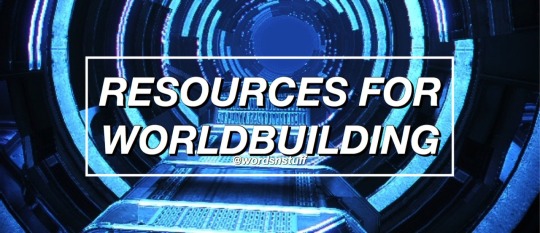
Culture & Society
Creating Fictional Holidays
Music For Your Fantasy World
Creating Religions & Belief Systems
How to Design Your Diabolical Cult
Historically Accurate Sexism in Fantasy: Let’s Unpack That
Debate with the Squirrels: Sexism in Fantasy
Feudalism
Using Politics In Fantasy Fiction
Mythic Justice – Crime and Punishment in Your Fantasy World
Government Worldbuilding
Realistic Political Strife
A Politics Of Worldbuilding
Language
Creating a Language
The Language Construction Kit
The International Phonetic Alphabet – Audio Illustrations
Fantasy Name Generator
Geographic Names
Medieval Names Archive
Squid Name Generator
Model Languages
Xenolinguistics
History
Prehistory
Mythos
History
Today
Myths, Creatures, and Folklore
Encyclopedia Mythica
The Ancient History Encyclopedia
Using History as Inspiration for Fantasy
Victorian Era Family Day Life in England
Peasant Life in the Middle Ages
Everyday Life in the Middle Ages
English Monarchs
Feudal Japan
The Story and Structure of the Iroquois Confederacy
Science + Geography
Dimensions
Solar Bodies
Climatology
Planetary Geography
Water Geography
Cartography, Maps, Star Charts, and Writing
Fundamentals of Physical Geography
Dating of Middle-earth events, using Precession of the Equinoxes and Tidal Friction
Orbital Operations in Science Fiction
Planet Designer
Artificial gravity calculator
Natural gravity calculator
Selden’s Catalogs of Objects for Celestia
Medieval Technology
Defining the Source, Effects, and Cost of Magic
How to Create a Rational Magic System
Miscellaneous
/r/worldbuilding
Fantasy World Generator
SciFi World Generator
Focused Ambiguity: Using Metaphor in Fantasy Writing
Space Engine
Terragen
The Five foundations of Worldbuilding
Setting the Fantastic in the Everyday World
Support Wordsnstuff!
If you enjoy my blog and wish for it to continue being updated frequently and for me to continue putting my energy toward answering your questions, please consider Buying Me A Coffee.
Request Resources, Tips, Playlists, or Prompt Lists
Instagram // Twitter //Facebook //#wordsnstuff
FAQ //monthly writing challenges // Masterlist
16K notes
·
View notes
Text
Words to replace said, except this actually helps
I got pretty fed up with looking for words to replace said because they weren’t sorted in a way I could easily use/find them for the right time. So I did some myself.
IN RESPONSE TO Acknowledged Answered Protested
INPUT/JOIN CONVERSATION/ASK Added Implored Inquired Insisted Proposed Queried Questioned Recommended Testified
GUILTY/RELUCTANCE/SORRY Admitted Apologized Conceded Confessed Professed
FOR SOMEONE ELSE Advised Criticized Suggested
JUST CHECKING Affirmed Agreed Alleged Confirmed
LOUD Announced Chanted Crowed
LEWD/CUTE/SECRET SPY FEEL Appealed Disclosed Moaned
ANGRY FUCK OFF MATE WANNA FIGHT Argued Barked Challenged Cursed Fumed Growled Hissed Roared Swore
SMARTASS Articulated Asserted Assured Avowed Claimed Commanded Cross-examined Demanded Digressed Directed Foretold Instructed Interrupted Predicted Proclaimed Quoted Theorized
ASSHOLE Bellowed Boasted Bragged
NERVOUS TRAINWRECK Babbled Bawled Mumbled Sputtered Stammered Stuttered
SUAVE MOTHERFUCKER Bargained Divulged Disclosed Exhorted
FIRST OFF Began
LASTLY Concluded Concurred
WEAK PUSY Begged Blurted Complained Cried Faltered Fretted
HAPPY/LOL Cajoled Exclaimed Gushed Jested Joked Laughed
WEIRDLY HAPPY/EXCITED Extolled Jabbered Raved
BRUH, CHILL Cautioned Warned
ACTUALLY, YOU’RE WRONG Chided Contended Corrected Countered Debated Elaborated Objected Ranted Retorted
CHILL SAVAGE Commented Continued Observed Surmised
LISTEN BUDDY Enunciated Explained Elaborated Hinted Implied Lectured Reiterated Recited Reminded Stressed
BRUH I NEED U AND U NEED ME Confided Offered Urged
FINE Consented Decided
TOO EMO FULL OF EMOTIONS Croaked Lamented Pledged Sobbed Sympathized Wailed Whimpered
JUST SAYING Declared Decreed Mentioned Noted Pointed out Postulated Speculated Stated Told Vouched
WASN’T ME Denied Lied
EVIL SMARTASS Dictated Equivocated Ordered Reprimanded Threatened
BORED Droned Sighed
SHHHH IT’S QUIET TIME Echoed Mumbled Murmured Muttered Uttered Whispered
DRAMA QUEEN Exaggerated Panted Pleaded Prayed Preached
OH SHIT Gasped Marveled Screamed Screeched Shouted Shrieked Yelped Yelled
ANNOYED Grumbled Grunted Jeered Quipped Scolded Snapped Snarled Sneered
ANNOYING Nagged
I DON’T REALLY CARE BUT WHATEVER Guessed Ventured
I’M DRUNK OR JUST BEING WEIRDLY EXPRESSIVE FOR A POINT/SARCASM Hooted Howled Yowled
I WONDER Pondered Voiced Wondered
OH, YEAH, WHOOPS Recalled Recited Remembered
SURPRISE BITCH Revealed
IT SEEMS FAKE BUT OKAY/HA ACTUALLY FUNNY BUT I DON’T WANT TO LAUGH OUT LOUD Scoffed Snickered Snorted
BITCHY Tattled Taunted Teased
785K notes
·
View notes
Text
Story Structures for your Next WIP
hello, hello. this post will be mostly for my notes. this is something I need in to be reminded of for my business, but it can also be very useful and beneficial for you guys as well.
everything in life has structure and storytelling is no different, so let’s dive right in :)
First off let’s just review what a story structure is :
a story is the backbone of the story, the skeleton if you will. It hold the entire story together.
the structure in which you choose your story will effectively determine how you create drama and depending on the structure you choose it should help you align your story and sequence it with the conflict, climax, and resolution.
1. Freytag's Pyramid
this first story structure i will be talking about was named after 19th century German novelist and playwright.
it is a five point structure that is based off classical Greek tragedies such as Sophocles, Aeschylus and Euripedes.
Freytag's Pyramid structure consists of:
Introduction: the status quo has been established and an inciting incident occurs.
Rise or rising action: the protagonist will search and try to achieve their goal, heightening the stakes,
Climax: the protagonist can no longer go back, the point of no return if you will.
Return or fall: after the climax of the story, tension builds and the story inevitably heads towards...
Catastrophe: the main character has reached their lowest point and their greatest fears have come into fruition.
this structure is used less and less nowadays in modern storytelling mainly due to readers lack of appetite for tragic narratives.
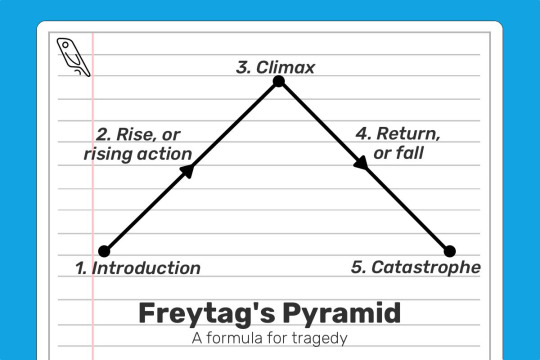
2. The Hero's Journey
the hero's journey is a very well known and popular form of storytelling.
it is very popular in modern stories such as Star Wars, and movies in the MCU.
although the hero's journey was inspired by Joseph Campbell's concept, a Disney executive Christopher Vogler has created a simplified version:
The Ordinary World: The hero's everyday routine and life is established.
The Call of Adventure: the inciting incident.
Refusal of the Call: the hero / protagonist is hesitant or reluctant to take on the challenges.
Meeting the Mentor: the hero meets someone who will help them and prepare them for the dangers ahead.
Crossing the First Threshold: first steps out of the comfort zone are taken.
Tests, Allie, Enemies: new challenges occur, and maybe new friends or enemies.
Approach to the Inmost Cave: hero approaches goal.
The Ordeal: the hero faces their biggest challenge.
Reward (Seizing the Sword): the hero manages to get ahold of what they were after.
The Road Back: they realize that their goal was not the final hurdle, but may have actually caused a bigger problem than before.
Resurrection: a final challenge, testing them on everything they've learned.
Return with the Elixir: after succeeding they return to their old life.
the hero's journey can be applied to any genre of fiction.

3. Three Act Structure:
this structure splits the story into the 'beginning, middle and end' but with in-depth components for each act.
Act 1: Setup:
exposition: the status quo or the ordinary life is established.
inciting incident: an event sets the whole story into motion.
plot point one: the main character decided to take on the challenge head on and she crosses the threshold and the story is now progressing forward.
Act 2: Confrontation:
rising action: the stakes are clearer and the hero has started to become familiar with the new world and begins to encounter enemies, allies and tests.
midpoint: an event that derails the protagonists mission.
plot point two: the hero is tested and fails, and begins to doubt themselves.
Act 3: Resolution:
pre-climax: the hero must chose between acting or failing.
climax: they fights against the antagonist or danger one last time, but will they succeed?
Denouement: loose ends are tied up and the reader discovers the consequences of the climax, and return to ordinary life.
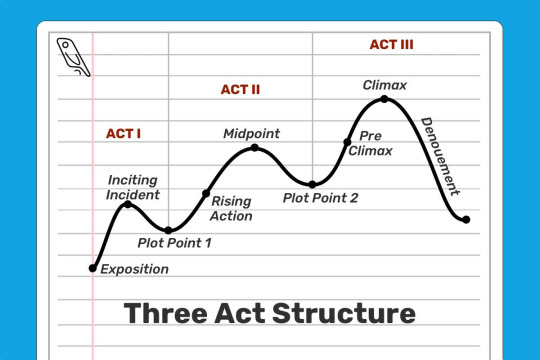
4. Dan Harmon's Story Circle
it surprised me to know the creator of Rick and Morty had their own variation of Campbell's hero's journey.
the benefit of Harmon's approach is that is focuses on the main character's arc.
it makes sense that he has such a successful structure, after all the show has multiple seasons, five or six seasons? i don't know not a fan of the show.
the character is in their comfort zone: also known as the status quo or ordinary life.
they want something: this is a longing and it can be brought forth by an inciting incident.
the character enters and unfamiliar situation: they must take action and do something new to pursue what they want.
adapt to it: of course there are challenges, there is struggle and begin to succeed.
they get what they want: often a false victory.
a heavy price is paid: a realization of what they wanted isn't what they needed.
back to the good old ways: they return to their familiar situation yet with a new truth.
having changed: was it for the better or worse?
i might actually make a operate post going more in depth about dan harmon's story circle.
5. Fichtean Curve:
the fichtean curve places the main character in a series of obstacles in order to achieve their goal.
this structure encourages writers to write a story packed with tension and mini-crises to keep the reader engaged.
The Rising Action
the story must start with an inciting indecent.
then a series of crisis arise.
there are often four crises.
2. The Climax:
3. Falling Action
this type of story telling structure goes very well with flash-back structured story as well as in theatre.
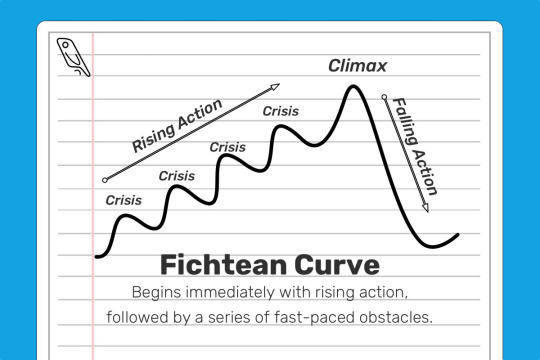
6. Save the Cat Beat Sheet:
this is another variation of a three act structure created by screenwriter Blake Snyder, and is praised widely by champion storytellers.
Structure for Save the Cat is as follows: (the numbers in the brackets are for the number of pages required, assuming you're writing a 110 page screenplay)
Opening Image [1]: The first shot of the film. If you’re starting a novel, this would be an opening paragraph or scene that sucks readers into the world of your story.
Set-up [1-10]. Establishing the ‘ordinary world’ of your protagonist. What does he want? What is he missing out on?
Theme Stated [5]. During the setup, hint at what your story is really about — the truth that your protagonist will discover by the end.
Catalyst [12]. The inciting incident!
Debate [12-25]. The hero refuses the call to adventure. He tries to avoid the conflict before they are forced into action.
Break into Two [25]. The protagonist makes an active choice and the journey begins in earnest.
B Story [30]. A subplot kicks in. Often romantic in nature, the protagonist’s subplot should serve to highlight the theme.
The Promise of the Premise [30-55]. Often called the ‘fun and games’ stage, this is usually a highly entertaining section where the writer delivers the goods. If you promised an exciting detective story, we’d see the detective in action. If you promised a goofy story of people falling in love, let’s go on some charmingly awkward dates.
Midpoint [55]. A plot twist occurs that ups the stakes and makes the hero’s goal harder to achieve — or makes them focus on a new, more important goal.
Bad Guys Close In [55-75]. The tension ratchets up. The hero’s obstacles become greater, his plan falls apart, and he is on the back foot.
All is Lost [75]. The hero hits rock bottom. He loses everything he’s gained so far, and things are looking bleak. The hero is overpowered by the villain; a mentor dies; our lovebirds have an argument and break up.
Dark Night of the Soul [75-85-ish]. Having just lost everything, the hero shambles around the city in a minor-key musical montage before discovering some “new information” that reveals exactly what he needs to do if he wants to take another crack at success. (This new information is often delivered through the B-Story)
Break into Three [85]. Armed with this new information, our protagonist decides to try once more!
Finale [85-110]. The hero confronts the antagonist or whatever the source of the primary conflict is. The truth that eluded him at the start of the story (established in step three and accentuated by the B Story) is now clear, allowing him to resolve their story.
Final Image [110]. A final moment or scene that crystallizes how the character has changed. It’s a reflection, in some way, of the opening image.
(all information regarding the save the cat beat sheet was copy and pasted directly from reedsy!)
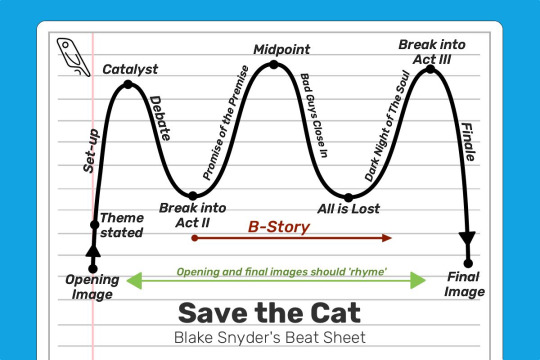
7. Seven Point Story Structure:
this structure encourages writers to start with the at the end, with the resolution, and work their way back to the starting point.
this structure is about dramatic changes from beginning to end
The Hook. Draw readers in by explaining the protagonist’s current situation. Their state of being at the beginning of the novel should be in direct contrast to what it will be at the end of the novel.
Plot Point 1. Whether it’s a person, an idea, an inciting incident, or something else — there should be a "Call to Adventure" of sorts that sets the narrative and character development in motion.
Pinch Point 1. Things can’t be all sunshine and roses for your protagonist. Something should go wrong here that applies pressure to the main character, forcing them to step up and solve the problem.
Midpoint. A “Turning Point” wherein the main character changes from a passive force to an active force in the story. Whatever the narrative’s main conflict is, the protagonist decides to start meeting it head-on.
Pinch Point 2. The second pinch point involves another blow to the protagonist — things go even more awry than they did during the first pinch point. This might involve the passing of a mentor, the failure of a plan, the reveal of a traitor, etc.
Plot Point 2. After the calamity of Pinch Point 2, the protagonist learns that they’ve actually had the key to solving the conflict the whole time.
Resolution. The story’s primary conflict is resolved — and the character goes through the final bit of development necessary to transform them from who they were at the start of the novel.
(all information regarding the seven point story structure was copy and pasted directly from reedsy!)
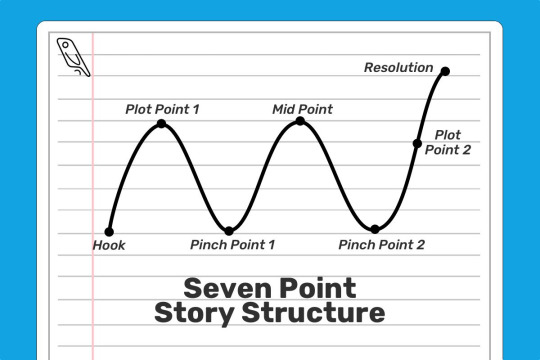
i decided to fit all of them in one post instead of making it a two part post.
i hope you all enjoy this post and feel free to comment or reblog which structure you use the most, or if you have your own you prefer to use! please share with me!
if you find this useful feel free to reblog on instagram and tag me at perpetualstories
Follow my tumblr and instagram for more writing and grammar tips and more!
13K notes
·
View notes
Text
The different schools of recent twine-adjacent interactive fiction
This is not a taxonomy; most games (especially those entered into IFComp and the like) will have multiple inspirations from multiple schools. This is an attempt to trace some of the broad tendencies in recent twine games.
The Post-Porpentine School: Porpentine's games were characterized by a fantastical surrealism and a philosophical or literary quality, while being about very personal or intimate topics. Many have elements of horror, oppression, and/or sexuality, and complex but ambiguous worldbuilding. Settings tend toward the dystopian, and many involve the protagonists reaching out for freedom in some way. Story branching is not a priority here but it may be present, and choice mechanics are often used more for aesthetics than for story branching. They tend to be at least moderately long, 30 minutes and up. This is probably the smallest school.
Examples: Porpentine's games (obviously), Solarium, We Are the Firewall, SPY INTRIGUE, Summit, DEVOTIONALIA, Heretic's Hope, Accelerate, BLK MTN, Consciousness Hologram/Universal Hologram, Computerfriend
The Post-Videogames School: The "Videogames" here refers to the book Videogames for Humans, edited by Merritt Kopas, and the games in this school share many characteristics with the games in that book. Alternatively, this could be called the Zinesters school or post-Anthropy school, after the book Rise of the Videogame Zinesters by Anna Anthropy. They tend to be short, less than 15-30 minutes, and tend to drill down on one particular moment or feeling or experience, without the burden of a heavily developed plot or setting. They tend to have hypertext-style choices. Aesthetics might be emphasized or ignored. Many are about mental illness or gender or sexuality, some anecdote from the author's own experiences, a political or social point, or just a quick joke. Many were made by students or for short game jams.
Examples: Most games from the book Videogames for Humans (with the notable exception of Horse Master), Detritus, The Writer Will Do Something, Gender Dysphoria, Time Passed, End of Life Care, Winter in June, Perseids, You Are Jeff Bezos, My Gender Is a Fish, fix it, Let's Talk Alex
The Choice of Games School: Based on the Choice of Games house style, these games use delayed branching as the primary narrative structure. They have character building based on a bevy of stats, heavy character customization including names and pronouns, and many romance options of many genders. Most stories tend to be "genre" as opposed to "literary". Most games are long, more than 2 hours, and have multiple branches and endings. There is little to no concern for aesthetics.
Examples: almost every Choice of Game and most Hosted Games. Fine Felines
The Tumblr School: this school originated in the choicescript diaspora, as many creators were dissatisfied with the terms Choice of Games/Hosted Games imposed on choicescript. Like CoG, they tend to have extensive character customization and romance options, use only end-of-text cyoa-style choices as opposed to hypertext, and are usually "genre" stories. Many are influenced by visual novels and otome games. They can be somewhat more experimental with the branching structure than CoG. Aesthetics are heavily emphasized, and often include character art. These games tend to be very long, and most are still in the development process, with a culture of periodic updates. Most will probably never be "finished".
Examples: Wayfarer, Stay? (partially, also adventure-puzzle), Superstition, A Tale of Crowns, Trigaea, everything on this itch.io page, most things submitted to the interact-if game jam, A Paradox Between Worlds (somewhat)
The Adventure-Puzzle School: These games are all about the systematic mechanics. Many of these games aim at implementing text adventure/parser-like mechanics in Twine, with object-based puzzles and directional movement. Some have more abstract mechanics, or RPG-inspired mechanics, or other types of simulations. They are usually on the lengthier side, but may be short with heavy branching. Aesthetics are not a priority.
Examples: Anything by Agnieszka Trzaska, Open Sorcery, 16 Ways to Kill a Vampire, Erstwhile, Seedship (might be its own sub-school), Beneath Fenwick, Orbital Decay, Voyageur, we, the remainder (also horror)
The Flash Horror School: Alternatively, the post-Nintendo school (for The Uncle Who Works At Nintendo). Like the post-Videogames school, these games tend to be short, focusing on one moment to the exclusion of an extended plot or setting. However, these games aim more directly at the emotions of horror and are less literal/anecdotal. Many have some nods to adventure-like mechanics, with locations and movement and such, but many do not. Aesthetics are highly emphasized.
Examples: the uncle who works for nintendo, my father's long long legs, Bogeyman, a man outside (plus many other games by litrouke), Contrition, Florence, The Waiting Room, Taste of Fingers
(the below are less "schools" exactly, more like broad trends or genres. These do not have a clear lineage like the previous ones.)
The Extended Character Study School: This was a hard school to pin down for me; I had originally called it the Brendan Patrick Hennessy school. They tend to be dialogue-heavy, and choice mechanics are generally used in service of characterization. Unlike the post-Porpentine school, these games tend to have more grounded settings and situations, although supernatural elements are often present. Coming-of-age is a common theme. They usually have strongly defined protagonists without character customization (or revolve around another character), and may or may not have story branching. They are usually at least moderately long.
Examples: Hana Feels, Venus Meets Venus, Birdland/Known Unknowns, Cactus Blue Motel, Will Not Let Me Go, The Master of the Land, Lore Distance Relationship, Pageant/New Year's Eve 2019, You Are SpamZapper 3.1, The Best Man
The Gamebook-CYOA School: This is sort of a catch-all group. Many developers are driven by nostalgia for paper gamebooks or CYOA stories, seeking to emulate those elements in a digital medium. Thus, they often have a similar philosophy as Choice of Games but without the detailed character customization, romance, or extensive stats. They are usually "genre" stories with some branching, and can be any length.
Examples: Cape, Ürs, Doppeljobs, The Golden Heist, Mermaids of Ganymede, The Last Doctor, some Hosted Games
The Literary School: These are games that aspire to be literature, or are more influenced by (static) literature or film/TV than they are by video games or other interactive fiction. They have a wider variety of themes than the post-Porpentine school, and are longer and have more developed stories than the post-Videogames school. They are often linear or close enough to linear.
Examples: Harmonia, At King Arthur's Christmas Feast
The Narrative Sandbox School: These games try to give the player lots of things to do. Unlike the Adventure-Puzzle school, these tend to not have puzzles as such, and may not have puzzly systematic mechanics.
Examples: Tavern Crawler, Animalia, The Master of the Land,
The NSFW School: To be honest, I do not have much experience with this, but I know it's kinda big, perhaps bigger than any of the other schools in terms of output.
Examples: look at the most popular interactive fiction games on itch.io with show nsfw turned on.
Other, smaller schools: lifeline-likes, lost phone-likes, dark room-likes, multiplayer games...
472 notes
·
View notes
Text
Please reblog to save a life
Okay, this is not easy for me. I’m giving my heart to 420 people out here, so please take this to consider.
Many of you have met me through my writing, shitty edits, I may have praised your work or even talked to you. I don’t know, but I’d love it if you stay, sit down and take 10 minutes to listen to my story. It may save a life, even your own.
My name is Noe, and I am a sexual assault survivor.
Also, if you think reading it will trigger you, please reblog it at least
Many of you know this story, but my blog keeps growing and this month is the Sexual Assault Awareness Month, so I think that my time is perfect. I will tell the story.
Keep reading
262 notes
·
View notes
Text

dr altair miyazaki
"I believe the only way to reform people is to kill them."
my lovely oc for @whatlovelybones-if [What Lovely Bones]
altair miyazaki | he/him | 26
red apple of his heart: park jae-sung
¬ A relatively happy-go-lucky guy that gives a smile as a sweet treat to anyone passing by but inside his heart is ice cold that only a select amount of things can warm up. Specifically providing the necessary method of "reform" needed.
Altair believes it is his god given duty to dish out punishment for those who abuse their power and the only method he needs is murder.
41 notes
·
View notes
Text
Lemonade-If MC
Saw an anon using this format for the MC and I thought why not, but seriously tho, this format is so cute i luv it
Hiroyuki Furuya, [M] Year 1 - Class A
"Furuya? Honestly, don’t know much about him. He just sorta… blends in? Anyways, why do ya wanna know?"
"That guy! Totes annoying. He just ignored me when I asked him what the answer was to question B in Sir’s class, but that’s not even the worst thing! Such a cute face is wasted on him."
"Yuki is, well, um… complicated? He is a nice person but he just doesn’t y’know… talk much. But you have to see him when he’s eating. He’s just like one huge blob of slime that consumes everything! One time I saw one of the bullies taking his lunch. And do you know what he did? He bit down hard, his arm was bleeding for days apparently…"
"Mr Furuya is, in the most professional term, a scientific anomaly. Somehow he is unable to absorb an ounce of knowledge into his brick-like brain but instead it seeps out. I truly pray for whoever has to teach him next year."
Ty for allowing me the pleasure of just fantasizing about a new slice-of-life school life!
and just for extra and because i cannot draw for the life of me i shall use picrew to express my oc btw im def going w/ Yuushin and Aleksei
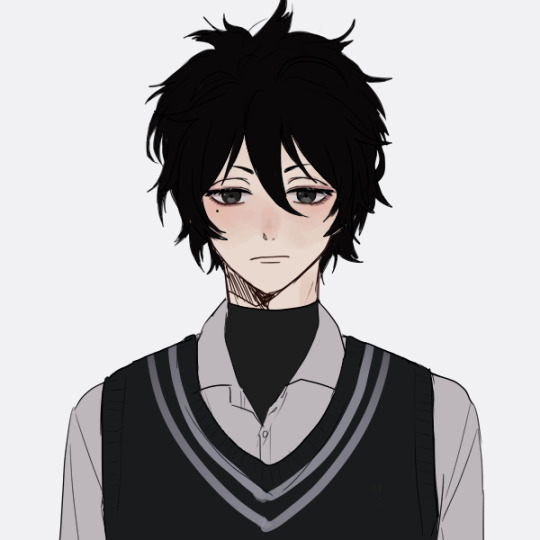
@lemonade-if
41 notes
·
View notes
Text
too much risk
Reblog or your mom will die in 928 seconds.
I love my mom.

I am risking nothing

I AM SORRY FOLLOWERS, I LOVE MY MOMMY
Will not risk.

sorry followers :(
5M notes
·
View notes